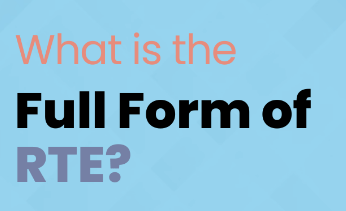Unveiling the Significance of RTE: Exploring the Full Form of RTE and Its Impact
rte full form In the realm of education and social reform, “RTE” is an acronym that holds immense significance. But what does RTE stand for, and what is its full form? In this article, we will embark on a journey to discover the full meaning of RTE and delve into its profound impact on the Right to Education.
The Full Form of RTE: Deciphering the Acronym
RTE stands for “Right to Education,” and it represents one of the most transformative and pivotal initiatives in the field of education worldwide. This acronym embodies a fundamental human right recognized by the United Nations and many countries.
1. Right to Education (RTE) in India:
In India, RTE is not just an acronym; it is a visionary piece of legislation known as the “Right to Education Act, 2009.” This act was enacted with the aim of providing free and compulsory education to all children aged 6 to 14 years. It ensures that every child, regardless of their socio-economic background, has the opportunity to receive quality education. The RTE Act is a monumental step towards achieving universal elementary education in India.
2. Right to Education Globally:
On a global scale, RTE represents a fundamental human right as recognized by the United Nations in the Universal Declaration of Human Rights (UDHR) and the International Covenant on Economic, Social and Cultural Rights (ICESCR). These international documents emphasize the importance of education as a basic human right and a critical tool for personal and societal development.
The Impact of RTE: Transforming Lives Through Education
The Right to Education is not just a legal framework; it is a powerful catalyst for change. Here are some of the ways in which RTE has a profound impact:
Universal Access: RTE ensures that education is accessible to all, promoting inclusivity and reducing disparities in educational opportunities.
Quality Education: It emphasizes the importance of quality education, focusing on factors such as infrastructure, curriculum, and teacher training.
Gender Equality: RTE plays a vital role in promoting gender equality by ensuring that girls have equal access to education.
Socio-economic Development: Education is a cornerstone of socio-economic development, and RTE paves the way for individuals and societies to thrive.
Empowerment: Education empowers individuals to make informed decisions, participate in civic life, and break the cycle of poverty.
Conclusion
RTE, or Right to Education, is not just an acronym; it represents a powerful force for positive change. Whether as the Right to Education Act in India or a fundamental human right globally, RTE embodies the belief that education is a transformative force capable of improving lives and societies.
As we celebrate the full form of RTE and its impact, we recognize that the journey towards universal education is ongoing. By upholding the right to education, we pave the way for a brighter and more equitable future, where every individual has the opportunity to learn, grow, and contribute to the betterment of our world.
Read more Demystifying APL In Academics: What Does APL Stand For?

